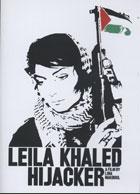
Leila Khaled: Hijacker 2005
Distributed by Women Make Movies, 462 Broadway, New York, NY 10013; 212-925-0606
Produced by Lina Makboul
Directed by Lina Makboul
DVD, color with b&, 58 min.
Sr. High - Adult
Biography, Gender Studies, History, Middle Eastern Studies, Political Science, Terrorism
Date Entered: 06/07/2007
Reviewed by Kim Davies Hoffman, State University of New York at GeneseoOn April 9, 1944, a baby girl, who would later become world famous, was born in the then Palestinian town of Haifa. Debate remains as to whether she came to fame for her heroism and ultimate passion for a cause, or if it was due to heinous and unmerciful acts of terrorism. It all depends on who is being asked. Either way, Leila Khaled bears the distinction of being the first female hijacker ever, and this riveting documentary recounts her story.
The journey of Leila Khaled: Hijacker unfolds through a mixture of black and white still photos; archival news reels of World War II and the Holocaust, the beginnings of the Arab-Israeli war, and the takeover and detonation of multiple aircrafts (most particularly TWA flight 840 (1969) and the 1970 Jordan retaliation bombings for landing El Al flight 219 and the subsequent detention of Leila Khaled), and personal interviews, then and now, of the hijacked victims, the pilots of those misfortuned planes, and Leila Khaled, herself. Through this varied and most effective use of media and historical accounts, Director and Producer Lina Makboul, a Palestinian-Swede, takes her audience from the Middle East (Haifa, Israel, Egypt, Lebanon, Jordan) to Western Europe (Germany, Rome, Amsterdam, London) and the United States.
Most notable is Makboul’s recent interviews with Leila Khaled—a woman in her sixties, married with two sons, and still very heavily involved in the fight for Palestinian liberation. Despite her beauty and youth during the hijackings, Khaled was viewed worldwide as a heartless villain. Through Leila Khaled: Hijacker, the audience sees her now as a “typical” mother who enjoys family dinners, walking her dog, the occasional cigarette, and visiting with friends. One might wonder how anyone so seemingly normal could have committed such atrocities. In a post 9/11 world, when the definition of terrorism has endured a radical transformation, viewers may find themselves empathizing with Leila Khaled. Her actions never killed innocent victims and her undying devotion to her cause may be seen as admirable. However, in this documentary, there is no visible remorse from a woman who changed the course of history and shaped a very different view of women’s capabilities. The film leaves us, and Leila Khaled, with one remaining question. Is it possible that for all of Khaled’s “bravery” and “heroism,” she has unintentionally caused a reversal in the desired global support for the Palestinians’ fight?
Technically, the documentary begins with rather bouncy film footage and throughout the film the transition of edited cuts is noticeably choppy. English subtitles with minor typos are used for those speaking Arabic, Swedish, and even English. The black and white quality is frequently grainy, but the underscore is haunting and instantly grabs hold of the film’s audience. Purchase price for Leila Khaled: Hijacker varies based on institutional size and scope, but a simple Worldcat search identifies very few libraries in possession of the three other videos featuring Khaled’s story. Thus, in most cases, interlibrary loan is not a feasible option. For any curriculum focusing on political terrorism, this documentary, in addition to some of the others (Women Suicide Bombers, Vision Entertainment, 2002; , In the Name of God, Films for the Humanities & Sciences, 2003 , Terrorism: Interview with Leila Khaled, World Affairs, 1997 ), is a must-have.
-
Awards
- Grand Jury Award, Tri Continental Film Festival, 2007, India
- Best Film Award, Nojesguiden Gothenburg, 2006
- Winner of Lena Hellman Memorial Fund, Tempo Film Festival, Stockholm, 2006